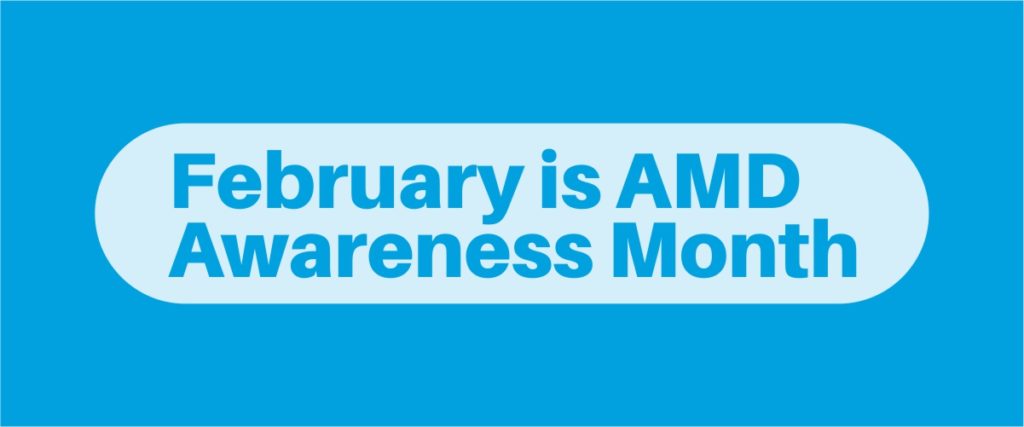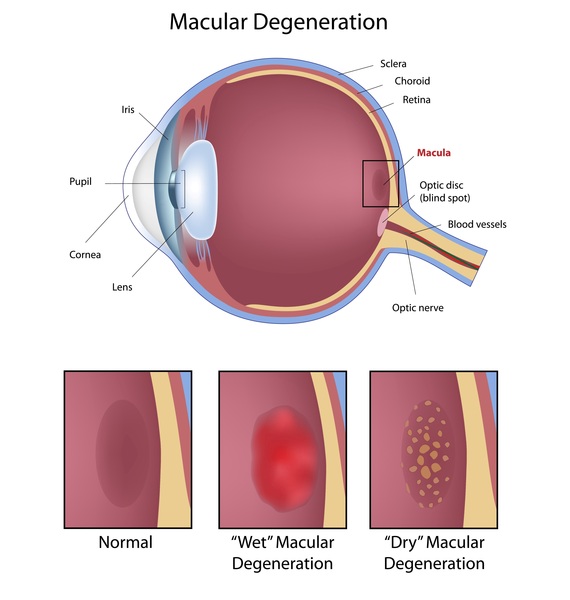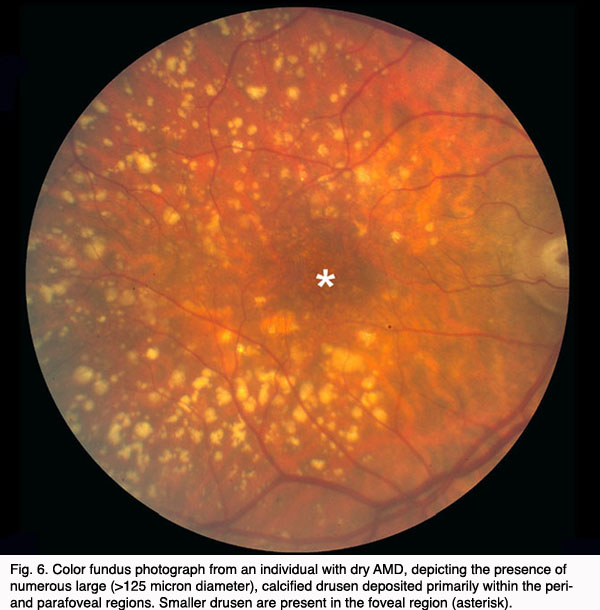Look Out For Your Eyes: Age-Related Macular Degeneration (AMD) and Low Vision

My very observant friend, who, in his younger days, smoked and had a regular glass of alcohol, was terrified when he realized that his vision was not as sharp as it once was. The decline in his sight did not happen overnight. My friend was genetically predisposed to diabetes, and his heyday lifestyle didn’t help. By 45, he was diagnosed with diabetes and was experiencing low vision. Objects were blurry in his central field of vision, the area that often deteriorates from macular degeneration. With changes to his diet and lifestyle, he managed his blood glucose levels very well. However, as he got older, he developed glaucoma and a further decline in his vision. His fear of blindness increased, and so too did his anger and frustration with each gradual loss of sight. Thanks to a network of people, he was able to learn strategies of vision rehabilitation which allowed him to stay active and avoid depression. Now 58 years old, my friend is fully blind but continues to lead a fulfilling and healthy life.
website https://www.aao.org/eye-health/diseases/low-vision
Sometimes we take life for granted and do not pay attention to what is happening around us. From a young age, I’ve always known that there was a relationship between diabetes and eye diseases, having seen many older adults living with diabetes become blind. However, when you see persons within your age group, losing their vision due to conditions such as diabetes, it can be frightening. For me, it signals the importance of living a healthy lifestyle regardless of whether you are living with diabetes or not.
When you consider that age-related macular degeneration (AMD) is the leading cause of low vision and blindness in Americans aged 50 years and older, and affects 1.6 million Americans, it should give us pause. As persons born between 1946 and 1967 ages, it is expected that the rate of AMD will reach “epidemic proportions.” Recent research presented by the BrightFocus Foundation stated that age is a prominent risk factor for age-related macular degeneration. The risk of getting advanced age-related macular degeneration increases from 2% for those ages 50-59 to nearly 30% for those over the age of 75.
Macular degeneration is expensive, and will only become more costly as the population aged 65 and older increases. The World Health Organization (WHO) 2018 report stated that the global cost of vision loss due to all causes is estimated to be nearly $3 trillion for the 733 million people living with low vision and blindness worldwide. In North America alone, the direct cost for vision loss due to all causes was $512.8 billion, and the indirect costs were $179 billion. If we bring these costs closer to home, we can see the financial impact of AMD on our insurance, the cost of individual healthcare, and the impact these costs will have on families.
What is AMD?
According to the National Eye Institute, age-related macular degeneration (AMD) is an eye disease that affects a part of your eye called the macula and which can blur the sharp central vision you need for activities like reading, cooking and driving. AMD often happens in older people. However, AMD may affect some younger persons slowly while other persons who have early AMD may not experience vision loss for a long time. AMD has been known to progress faster in some persons and can lead to central vision loss in one eye or both eyes. It is important to note that early AMD doesn’t have any symptoms, and it is necessary to have a regular eye examination if you are at risk.

AMD is a progressive disease with no known cure. It slowly steals vision as it affects the retina, a paper-thin tissue lining the back of the eye, and causes the cells in the area to die. As a result, if you have AMD, you see blind spots, grayness, and other distortions in the center frame of your vision.
Forms of macular degeneration
The “dry form” of macular degeneration, in which the light-sensitive cells of the macula slowly break down. It is the most common type and accounts for 90 percent of diagnosed cases.
“Wet” macular degeneration accounts for approximately 10 percent of cases, but results in 90 percent of legal blindness. It is considered advanced macular degeneration (there is no early or intermediate stage of wet macular degeneration). The dry form of the disease always precedes wet macular degeneration.
Dry macular degeneration can advance and cause loss of vision without turning into the wet form of the disease; however, it is also possible for early-stage dry age-related macular degeneration to suddenly change into the “wet form.”

Stages of AMD
The American Macular Degeneration Foundation recognizes three phases of macular degeneration: early, intermediate, and late. Those phases are determined by the symptoms doctors can see as well as the symptoms you might report to a doctor. What you should do at each stage of the disorder varies.
In the early stage, you may have no vision issues, but your doctor might advise you to make some lifestyle changes to keep the disorder from progressing. In the intermediate stage, you may begin to experience difficulty with central vision, and your doctor may ask you to use vitamins to slow progression. In the late stages, you may have trouble seeing clearly. Your doctor may advise surgery, or you may consider working with an occupational therapist.
On average, it takes about 10 years to move from diagnosis to legal blindness, but there are some forms of macular degeneration that can cause sight loss in just days. As the Foundation Fighting Blindness puts it, your vision may be stable between doctor’s visits, but that does not mean that the condition is reversing. It can mean that you are doing an excellent job of keeping rapid deterioration from taking hold. Unfortunately, some forms of macular degeneration can cause a rapid deterioration of vision.
In some cases of “wet forms” macular degeneration, the rapid loss of vision can occur when the growth of blood vessels deep within the eye leak or burst. According to The American Journal of Managed Care, some people lose their sight within days of experiencing symptoms. You must visit a doctor and explain your symptoms as soon as they appear. Sudden changes in what you can see could indicate that your eye health is changing, and there are therapies available for the unusual blood vessels growing within your eyes.
Potential vision-related symptoms
• More light is needed for tasks such as reading
• A blurry spot appears in the center of the visual field
• A blurry spot becomes larger and darker
• Straight lines may appear wavy
• Straight-ahead vision becomes distorted or lost entirely in a short period
Do not delay in informing your doctor of any changes in your sight. These changes may be indicators of the potential damage that can be permanent, which happens very quickly.
Risk Factors for AMD
Your risk for AMD increases as you get older. People over age 50 are more likely to have AMD. The risk for AMD is also higher for people who:
• Have a family history of AMD
• Are Caucasian
• Smoke
If you are at risk for AMD because of your age, family history, or other factors, it’s important to get regular eye exams.
Reducing Risk for AMD
Even though there is no known cure for AMD, practicing healthy daily lifestyle habits can reduce your risk for it. A healthy diet, not smoking, and maintaining healthy blood pressure are critical first steps.
6 Steps to Better Eye Health
Other healthy habits that can lower the risk of AMD include:
- Get an annual eye exam
- Stop smoking
- Protect your eyes. Wear sunglasses and a hat with a visor in bright sunlight to protect your eyes from potentially harmful ultra-violet (UV) light and blue light
- Use the 20-20-20 rule regarding digital devices. Every 20 minutes, take a 20-second break and focus your eyes on something 20 feet away
- Nourish your eyes with nutrients found in a healthy diet. Eat meals with plenty of green, leafy vegetables such as kale, spinach, and collard greens, and fresh fruit. Include fish that is high in omega-3 fatty at least once or twice a week. Types of fish that are high in omega-3 fatty acids include salmon, sardines, mackerel, herring, and albacore tuna.
It’s important to keep your body healthy. Maintain a healthy weight, exercise regularly, maintain healthy blood pressure and cholesterol levels. The healthier your body, the more it can foster good eye health.
Although vitamins cannot prevent AMD, you may be able to slow the disease progression with vitamin supplements that contain vitamin C and E, copper, lutein, zeaxanthin, and zinc. Another way to slow the disease’s progression is to maintain a healthy heart. Your eyes rely on a healthy cardiovascular system, and that means paying attention to the food and lifestyle choices that you make. It’s ok to take baby steps towards positive lifestyle changes.
Getting the right information is necessary to get the best treatment options available. When it comes to low vision caused by AMD, there is innovative technology available that will enhance low vision. Ask your doctor about these treatment options.
Life does not end with AMD or low vision. The key is not feeling isolated if you have it. Keep your social group, job, or outside activities. You might need large print, a magnifier, someone to drive you to events, or assist you in doing the things you love. Staying home to avoid asking for help is not independence, and your friends or community support group will love to help. Ask for the help you need.
Financial Assistance
Learn about financial aid resources that may be available to help cover the costs of your macular degeneration prescription medications. https://www.brightfocus.org/macular/article/financial-aid-macular-medications
Source:
Photo of dry AMD: https://webvision.med.utah.edu/book/part-xii-cell-biology-of-retinal-degenerations/age-related-macular-degeneration-amd/
https://lowvisionmd.org/february-is-amd-macular-degeneration-low-vision-awareness-month/
https://www.nei.nih.gov/learn-about-eye-health/eye-conditions-and-diseases/age-related-macular-degeneration
https://www.nvisioncenters.com/macular-degeneration/sight-loss-timeline/
https://www.brightfocus.org/macular/article/macular-frequently-asked-questions
https://www.aao.org/eye-health/diseases/low-vision